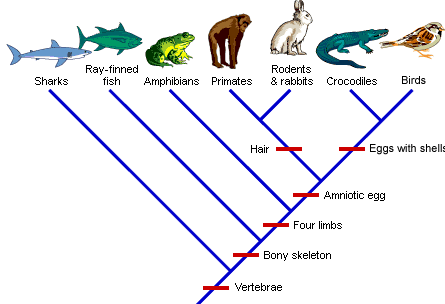Chapter 18 - What Do You Know?
1. Every organism's scientific name consists of [ one | two | three ] words.
2. "Sea Monkey" is an example of a [ common name | scientific name
].
3. The science of naming and classifying organisms is called[ nomenclature |
taxonomy ]
4. Organisms in the same genus, such as Canis lupus and Canis familiaris MUST
also belong to the same
[ species | phylum ].
5. The taxon (group) directly under Phylum is [ class | order ].
6. Plantae and Animalia are two examples of [ species | kingdoms ].
7. Organisms that can interbreed with one another are classified as the same[
species | genus ].
8. The evolutionary history of a species is called [ phylogeny | taxonomy]
9. Biologists usually classify things according to their [ habitat | appearance
]
10. The naming system developed by Linnaeus is called[ systematics | binomial
nomenclature ]
11. Organisms with the names: Quercus rubra and Quercus phellos belong to the
same [ genus | species ]
12. The taxon (group) directly below Order is [ family | class ]
13. For black bears and polar bears to be in the same family, they must also
be in the same [ genus | order ]
14. The second word of a scientific name is always [ capitalized | lowercase
]
15. The scientific name is always written in [ all capitals | italics ]
Review Guide
 1. Define Taxonomy
1. Define Taxonomy
2. Understand how scientific names are assigned.
3. Distinguish between scientific names and common names
4. What is binomial nomenclature?
5. What can the scientific name of an organism tell you about what its related
to?
Ex. Ursus arctos, Ursus maritimus
6. Be able to list the levels of Linnaeus's classification system, in order.
7. How are organisms classified? (How do scientists figure out animals to put
in each group)
8. What is phylogeny?
9. Be able to interpret a cladogram.
10. Be able to use a dichotomous key to identify the species name of an organism.
11. Name the three domains and what organisms belong to each.
12. Name the six kingdoms and what organisms go into each.
13. Describe the four kingdoms belonging to the Domain Eukarya. What is the
basis for grouping organisms into those kingdoms?
14. Distinguish between unicellular and multicellular.
15. Distinguish between heterotroph and autotroph.
16. Distinguish between eukaryote and prokaryote.